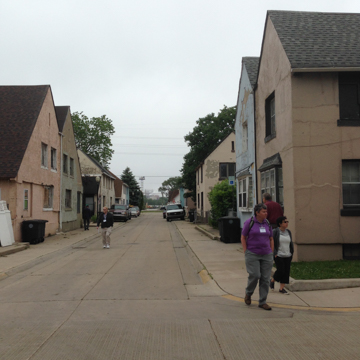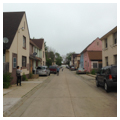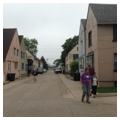In 1914 industrialist Clayton Mark expanded his Chicago-based Mark Manufacturing Company by building a steel mill in East Chicago, Indiana, an area ripe for industrial development due to its open land and proximity to Lake Michigan. The dunes and marshlands were viewed at the time as worthless, although today a remnant of that land has been preserved as the Indiana Dunes National Lakeshore a few miles to the east. In order to build, the swampy land had to be filled in to make it suitable for construction. There was little in the way of housing and commercial amenities to accommodate Mark’s employees, so he commissioned architect Howard Van Doren Shaw to design a model town adjacent to his factory. Mark knew Shaw’s work well—the architect had designed Mark’s residence and several others in the affluent Lake Forest north of Chicago, and in 1915 he also designed in that town a new shopping center, Market Square, one of the first of its kind in the country, which had been inspired by a recent European trip. That same trip clearly influenced Shaw’s design for Marktown.
Construction on Marktown began in 1916. The original plan was for a much larger community of workers’ houses and amenities but only about ten percent was actually built, owing to America’s entry into World War I in 1917. Still, it was sufficient to create the illusion of a small English village surrounded by greenspace, with a market square at the north end. (If the town had been completed, the market square would have been in the center.) The Tudor Revival buildings, a mix of two-story structures with gabled or hipped roofs, include single dwellings, doubles, and larger multiple family units. The streets are extremely narrow, with a right-of-way of only 32 feet, adding to the village feel. While automobiles were rare among the residents (and scarcely needed) when Marktown was built, subsequent generations have had to park their cars on the sidewalk and walk on the street.
Construction did not resume after the war ended. The Mark Manufacturing Company merged with the nearby American Sheet and Tube Company, which, in turn, was purchased by Youngstown Sheet and Tube Company in 1923. The sale included the company town but during World War II Youngstown sold off the town to individual owners, although the cohesiveness of the community remained for decades, even as industrial expansion encroached upon their little neighborhood. Cut off by an aging and largely derelict industrial corridor and the Indiana Harbor Canal, Marktown declined throughout the second half of the twentieth century.
Marktown is now completely surrounded by BP, ArcelorMittal Indiana Harbor, and US Steel’s tin plant. Still, intermittent efforts toward preservation and revitalization have continued for decades. In 2008, Marktown was identified as an important architectural, historical, and cultural resource in the Marktown Revitalization Plan, commissioned by the City of East Chicago. But the behemoth oil corporation BP, headquartered practically next door to Marktown in adjacent Whiting, sought expansion room for their refinery in 2013, chiefly for a parking lot. BP began buying up individual properties in Marktown, and demolitions began in May 2014. The loss of such a substantial percentage of buildings, most of which had been considered good candidates for rehabilitation, does not bode well for the former company town.
References
Bauer Latoza Studio. “Marktown Revitalization Plan.” Prepared for the City of East Chicago, December 2008.
Moore, Powell A. The Calumet Region: Indiana’s Last Frontier. Indianapolis: Indiana Historical Bureau, 1959.
Morrisroe, Richard, “Marktown Historic District,” Lake County, Indiana. National Register of Historic Places Inventory–Nomination Form, 1975. National Park Service, U.S. Department of the Interior, Washington, D.C.




